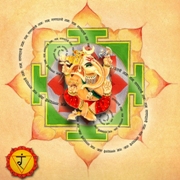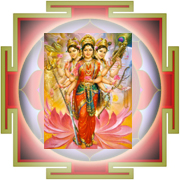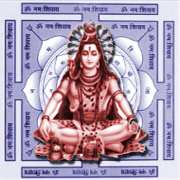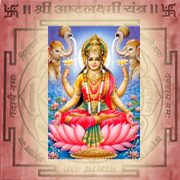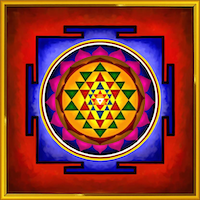Tantra
The shortest route to liberation
Scientific studies have proven that with passing time the life span and strength of beings of this yuga is decreasing and diminishing. Ancient texts describe the ages of earlier beings to span over centuries and certain rishis find description in three yugas. But as the yugas changed, as predicted by Rishi Markandeya, the strength, vitality and life span of beings of Kaliyug has come to a fraction of what it used to be.
The mystical science of tantra stands most relevant in this age, when life spans are short and people do not live till ripe old ages to perform sadhnas earlier rishis used to perform. It is the shortest route to liberation in this age.
Tantra is Instant Manifestation
Tantric sadhnas yield results there and then. Siddhis are granted instantaneously. But Tantra is the most misunderstood of all spiritual sciences. It is unfortunate that today tantra is connoted to kamasutra and sexual gratification. Nothing can be more demeaning and ironical than presenting a Tantric, the master of the senses and physical matter as a slave of the senses and material accomplishments.
The Cosmic Union of Shiv and Shakti
Mahayogi Adi Guru Lord Shiva first gave the science of Tantra and Yoga to Mother Parvati. Mother Adi Shakti incarnated, only after which She realised the creation and its forces in totality and her true potential as Shakti. Thence Lord Shiva and Mother Parvati united as Ardhnareshwar, purush (male) and prakriti (female), the form which is the basis of Tantra as it denotes the union of elements and consciousness, the Creation. The union of Shiva and Shakti, the male and the female forces of nature represent non-duality, the advaita philosophy in Tantra. In creation purush and prakriti are inseparable, just as matter is inseparable from energy. One force is latent and the other is active. Practices in Tantra brings them in equilibrium and the ultimate state of reality is achieved. It is the science of super consciousness, and reveals supreme reality, nothing remains hidden or out of reach for a practitioner of Tantra and he obtains powers called siddhis which control the forces of nature. He becomes a master and not a slave to physical attributes of matter, which the senses signify.
Matter and Consciousness
In Tantra, body is taken as an aid, a vehicle, a machine which enables your journey. In fact, the body becomes a microcosm of creation. All the forces of creation can be roused from the body - heat, cold, vibration, motion, sound, silence. A human being composed of matter and consciousness can permutate these resources in any form with Tantra. But before that, one has to understand that this universe is nothing but, purush and prakriti, matter and consciousness in varying frequencies. Matter is five elements- prakriti - Shakti, and purush is consciousness - Shiva. Even the bodies of a man and a woman comprise of purush and prakriti both, only one is more pronounced, other latent. Ratnasara Tantra explains, he who realises the truth of the body can then come to understand the truth of the universe. Kularnava Tantra has also emphasized that human body, out of all the bodies is the most difficult to come by, both devtas and pitris (spirits) desire it, as it can take you to boundless states, and therefore the human birth is the most precious to attain.
Tattwa shuddhi
Tattwa shuddhi, purification of the elements brings the consciousness to that level where this differentiation between different states of matter is mitigated and consciousness becomes powerful enough not to be subdued by the senses. The body then becomes the greatest tool.
The practice of Tattwa Shudhi (Purification of elements) finds its description in Srimad Devi Bhagvatam. Its sole purpose is evolution and it primarily deals with the elements and their purifications. Though several yogic and tantric practices are designed to increase the flow of prana in the being's body, the specific practice of 'Tattwa Shuddhi' does both - it increases and transforms prana.
We know that our physical body comprises of the five elements: prithvi (earth), jal (water), agni (fire), vayu (air), and akash (ether). Each one of us has all these five elements, though its different composition makes us different individuals. The impurities in these elements determine our present state of existence. Evolution, for a normal being is moving from one state of existence to the other. So to move from one form to the other we need to get rid of these impurities.
For this a certain disturbance or vibration is created in the body, which in turn causes a kind of imbalance in the present state of our elements. It is only then that a new, higher state of balance can be reached.
This practice through inner concentration on the yantras directly influences all the chakras, creating a heightened awareness and experience of that specific element and the various attributes attached with that chakra and its respective element.
So when you reach the purest state of all elements through the practices you will reach the periphery of the Bhu Lok, ready to move into the Bhuva Lok, the next higher level of existence.
The process of purification for this practice starts from the lower, grosser levels and goes on to the subtlest levels. It starts from external purifications like bathing and cleansing the physical body. After bath, bhasm (ashes) is applied on the forehead. The bhasm is indicative of dissolution of elements; for it is believed that whatever substance one applies to one's body the gyan or the essence of that substance permeates into the person. One is also required to make a sankalp or resolve to perform this sadhna for a specified number of days. The place of worship remains the same, that is to say, one should perform this sadhna at the same place and time every day. On completion of the sankalp, silence or maun is maintained.
Tattwa Shudhi is meant only for sadhaks who have reached a certain level of mastery over their bodies because it requires the sadhak to sit in siddha asana for long periods of time. It also requires one to monitor his or her diet and keep it light, because when the elements begin to get lighter or subtler, the heaviness of food tends to affect them as it induces sleep, indigestion, etc. It is a practice which cannot be done without the sanidhya of a Guru.
Mantras and Yantras
Tantra uses mediums of sounds (dhwani) in the form of mantras and diagrammatic representations of these sounds called yantras in specific procedures.
Mantras are codified sounds and are used to alter the states of matter in creation. Science has now proven to some extent the efficacy of sounds in moving/levitating objects, purifying states of matter and healing aspects in various experiments cited under mantras - science of sound. These sounds when pronounced in a specific manner and a given number of times form the body of a Deva - God/spirit energy. In the universe, there are innumerable aspects of creation which are governed by different forms of spirits. Devas/Devtas are considered positive forces in creation who maintain the balance in nature by looking after the governance of nature in a harmonious way. So Devtas are as many as there are different aspects of creation. Every tantric sadhna is attributed to a specific energy, has its specific beej mantra and invokes the specific shakti which resides in that mantra, which is represented in geometrical patterns of a yantra.
Lets try and understand it first with the help of chakras in a human being. There are eight chakras in a human being. The first one is mooladhar, at the perineum, the base of Sushumna nadi running along your spine. It is depicted as a 4 petal lotus flower. It has its beej mantra- lum, and is associated with the element earth. So it has a name, a form and shakti, the energy called Dakini. Dakini opens the doorway into the Sushumna nadi, the subtle channel, through which Kundalini Shakti, the serpent power rises to pierce the eight chakras and endows one with knowledge of Tattwas, elements. Similarly the rest of the chakras are attributed with their respective beej mantras, yantras, elements and shakti. Tattwa shudddhi abhyasa reveals the subtle aspects of these elements and chakras to the devoted sadhak even in today's age.
The Kiln of Niyam
Tantra requires strict discipline and adherence to time/niyam. For specific objectives there are specific number of chants, specific times of the day and a correct pronunciation. Tantra is very systematic and follows a specific rhythm. One has to maintain a specific posture, generally Siddhasana or Padmasana. Even the place of the sadhna is very specific; there are certain sadhnas which cannot be performed at home, or in domestic environments. For example a specific sadhna is only to be performed at shamshaan (cremation grounds) for the energies which are called require/dwell only in that kind of atmosphere. Now one gentleman refused to follow the strict discipline tantra requires, and exercising free will started the sadhna at his home. Slowly one after the other his whole family ended up in crematorium. The energies create the environment they require. When called, they are bound to come. With no one remaining in the house, the house itself became shamshaan , vacant of all beings living, so this is what the dos and the don'ts in Tantra stand for. One has to adhere to rules; a small mistake can create havoc in your life, and the actions and their reactions are irreversible.
The Panch Makaras
Tantra is a like a highly potent device, which can make things happen at your call. It was devised for the benefit of mankind, to evolve, to achieve perfection and liberation - freedom from the vicious circle of senses and maya. No tantric practice involves any ritual of harming another being by means of bali or sacrifice. Rather it is about self conquest, conquering your desires and mastering yourself, strengthening your weakness. Many tantrics talk about panch-makaras or 5 elementary practices viz. madya, mansa, matsya, mudra and maithuna. As in Tantra the practices and techniques are generally described allegorically or symbolically, panch-makaras are not to be taken literally. The Guru deciphers the symbols and techniques and gives an insight to the disciple of such practices.
- Madya which literally means wine or intoxication actually stands for the nectar which drips from bindu visarg when deeper practices and pranayamas are performed.
- Matsya represents movement of prana through Ida and Pingala nadis as a result of the practice of pranayamas. Ida and Pingala criss cross like the movement of fish, which stands for matsya. They establish balance in the body for Kundalini, the serpent power to move in Sushumna nadi.
- Mudra is gesture/posture, and here it stands for Khechari mudra, where tongue is rolled up to touch the soft palette, which releases pranic energy to reach the bindu from where the nectar drips. Some tantrics also believe it to be dhanya, cereal.
- Mansa or meat is generally understood as offering meat - animal or human sacrifice but tantra is far away from such practices which inflict even slightest amount of pain to any being. Bali or sacrifice actually means offering what you have or what you are. You cannot control a single moment of your life, a single breath, so how can you offer life of another being who does not belong to you. Bali is offering what is yours and even your own body is not yours, you possess only one thing and that is your ichcha/desire. So mansa symbolises sacrificing yourself by winning over your desires.
- Maithuna which is misunderstood to be sexual intercourse is actually the union of purush and prakriti. It is not physical union of a male and a female but the purush and prakriti aspects of a being, Shiva and Kundalini, the ultimate state of dhyan called samadhi and it requires complete control over your physical senses.
By attainment of mudra and pranayama (matsya), the nectar is obtained, winning over the desire (mansa/bali) induces the state of union or maithuna, the ultimate objective of tantra/yoga, where no distinction remains between physical elements of nature.
Aghoris, Avdhoots and Tantrics
The Aghoris/Aughads are Tantrics who are generally taken to be cannibals dwelling in charnel grounds. But the fact is that they do not distinguish between matter in different forms and therefore embrace all states of matter without distinction, so they can be seen in cremation grounds just as well as they wander any other part of earth. They are not to be mistaken for the opium smoking cannibals, dwelling in cremation grounds, they are in fact masters of the elements and can change the elements at their will, what is generally seen on TV of Aghori is merely a projection rather than a real Aghori. Aghoris do not entertain people for they have no business with the world other than their own, they would never show themselves on TV or cameras and do not get into conversations with normal people.
Avdhoots are adepts who do not adhere to any social etiquette and embrace nature in non-dualistic form, advaita principle, so much so that they do not even associate with names given to them. Beyond the limitations of the body and the senses they belong nowhere and give up any identity which connects them to the physical world, as is explained in Shiv Smaran Stotra -"naamadi bheda rahitam", free of name and any distinction, "shadbhavshoonyam"- free of all sensual afflictions, following the tradition of Lord Shiva. It is unfortunate that in today's time people who call themselves Avdhoots are busy selling knowledge or various kind of vidyas and teaching people how to make a business out of them; they are a shame in the name of an Avdhoot.
Any Tantric or Aghori or Avhdhoot in actual sense of word is a reflection of Lord Shiva, the greatest Aghori, Avdhoot or Tantric whatever the sadhak may choose to see Him as, free of all worldly afflictions and bondages. They do not form a part of the material world, for they belong to a dimension which is beyond sex, money and desire, completely merged in Lord Shiva, their ishta deva, who does not distinguish between matter and its forms, sur or asur, paap or punya or lays importance to relations or emotions. In His chidanand rupa, a Tantric/Aghori/Avdhoot is one with Lord Shiva, as Adi Shankara described- Shivoham Shivoham.

